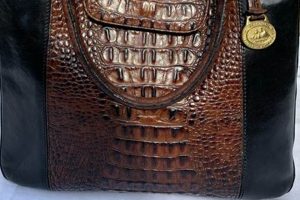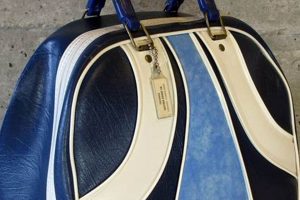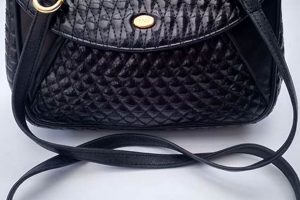A pre-owned Louis Vuitton handbag represents a tangible connection to the esteemed history of a luxury brand. These articles, often characterized by distinctive design elements and materials from specific periods, offer a glimpse into the evolution of fashion and craftsmanship. For example, a Speedy bag from the 1980s, with its vachetta leather handles and iconic monogram canvas, embodies a distinct aesthetic representative of that era.
Possessing an older Louis Vuitton piece provides advantages beyond mere aesthetics. These items frequently retain, or even increase, in value over time, making them potential investment opportunities. Their acquisition also aligns with sustainable practices by extending the life cycle of existing goods, reducing demand for newly manufactured products. Furthermore, these objects offer historical context, reflecting the design sensibilities and cultural influences prevalent during their production.
The subsequent sections will delve deeper into identifying authentic examples, evaluating their condition, understanding their market value, and exploring the best avenues for acquisition or sale. Considerations will include factors such as canvas type, hardware details, stitching techniques, and overall provenance in determining authenticity and value.
Valuable Insights Concerning Older Louis Vuitton Handbags
The following constitutes essential advice for navigating the acquisition, authentication, and maintenance of these luxury items.
Tip 1: Scrutinize Serial Numbers/Date Codes: Louis Vuitton began incorporating date codes in the early 1980s. These codes indicate the week/month and year of manufacture. Locate the code, which is typically found inside pockets or under linings, and verify its consistency with the production era of the specific article. Discrepancies or absence of a date code on a bag that should have one can indicate inauthenticity.
Tip 2: Evaluate Canvas Integrity: Authentic Louis Vuitton canvas is renowned for its durability. Examine the canvas surface for signs of cracking, peeling, or excessive wear. A genuine item will exhibit consistent color and pattern alignment, particularly at seams. Variations from this standard suggest a counterfeit.
Tip 3: Assess Hardware Quality: Authentic Louis Vuitton hardware is crafted from solid brass or metal alloys and features consistent coloring and precise engravings. Inspect zippers, clasps, and rivets for tarnishing, pitting, or irregularities in finish. Fakes often use inferior materials leading to rapid degradation.
Tip 4: Analyze Stitching Precision: Louis Vuitton employs meticulously executed stitching techniques. Observe the stitch count per inch, the straightness of the stitch lines, and the uniformity of the thread color. Irregularities or inconsistencies in the stitching are common indicators of counterfeit production.
Tip 5: Examine Vachetta Leather: The vachetta leather used on many Louis Vuitton bags develops a patina over time. A genuine vachetta will darken naturally with exposure to light and oils. A suspicious vachetta is the one that is plastic-looking or very obviously painted.
Tip 6: Research Specific Models: Acquaintance with the characteristics of specific Louis Vuitton modelsincluding their dimensions, construction details, and hardware configurationsis critical. This knowledge aids in identifying discrepancies that may indicate inauthenticity.
Tip 7: Seek Professional Authentication: For high-value or questionable items, consider engaging the services of a reputable authentication service. These experts possess the knowledge and tools necessary to conduct thorough examinations and render definitive opinions on authenticity.
Adherence to these guidelines facilitates informed decision-making, safeguarding against the acquisition of counterfeit merchandise and ensuring the enduring value of acquired articles.
The subsequent discussion will address common misconceptions and persistent rumors surrounding these items, providing clarity and dispelling inaccuracies.
1. Authenticity
The genuine nature of a pre-owned Louis Vuitton handbag is paramount to its value and desirability. Rigorous authentication is essential to ensure one is acquiring a legitimate item rather than a counterfeit, which lacks the inherent quality and investment potential of the original.
- Date Codes and Serial Numbers
Louis Vuitton introduced date codes in the early 1980s as internal tracking mechanisms. These codes, often located discreetly within the bag, indicate the year and month (or week) of manufacture. Serial numbers, used in later models, serve a similar purpose. A mismatch between the date code/serial number and the known production period of a particular model raises immediate concerns about its genuineness. Absence of a date code in a model that should possess one is also indicative of a potential counterfeit.
- Stitching and Construction Quality
Louis Vuitton employs precise stitching techniques, characterized by consistent stitch length, even spacing, and durable thread. The number of stitches per inch is also a key indicator. Irregularities, such as uneven stitching, loose threads, or variations in stitch count, often signify inferior craftsmanship associated with counterfeit products. The overall construction of the bag, including the alignment of seams and the symmetry of its design, should also adhere to strict standards.
- Hardware Detailing and Engravings
Authentic Louis Vuitton hardware, including zippers, clasps, buckles, and rivets, is typically crafted from high-quality metals with a consistent finish. Engravings, such as the Louis Vuitton logo or model name, are precise and well-defined. Counterfeit hardware often exhibits inconsistencies in finish, such as pitting or tarnishing, and the engravings may be poorly executed or inaccurately placed. The weight and feel of the hardware can also be indicative of its authenticity.
- Canvas and Leather Characteristics
The canvas used in Louis Vuitton bags is known for its durability, water resistance, and distinctive texture. The pattern alignment on monogram canvas is meticulously matched at seams. Counterfeit canvas may feel thin, have an irregular texture, or exhibit pattern misalignment. The vachetta leather, used for handles and trim, develops a characteristic patina over time. The natural aging process should appear even and consistent, whereas counterfeit vachetta may appear overly glossy or have an unnatural color.
Successfully discerning authenticity is an ability gained through diligent research and comparison. Scrutinizing these facets of a Louis Vuitton bag proves critical in preventing acquisition of counterfeit merchandise, preserving the value, and fully appreciating the heritage of an authentic item. It is better to rely on experienced individuals to verify to ensure the purchase is valid.
2. Condition
The state of preservation significantly impacts the desirability and monetary value of a pre-owned Louis Vuitton handbag. A thorough evaluation of its condition is crucial for both prospective buyers and sellers, influencing pricing, restoration decisions, and overall satisfaction.
- Canvas Integrity
The canvas, the primary material in many Louis Vuitton designs, should be examined meticulously. Cracking, peeling, fading, or staining diminishes the bag’s appeal and structural integrity. Examples include cracks near stress points, such as the base of handles or corners, and discoloration caused by prolonged exposure to sunlight. Severe canvas damage can necessitate costly repairs or render the item unsuitable for purchase.
- Vachetta Leather Patina and Damage
The vachetta leather, often found on handles, straps, and trim, develops a patinaa darkening and softeningover time. While a uniform patina is generally desirable, excessive darkening, water stains, or cracking compromise the aesthetic and potentially the structural soundness of the leather. Examples include water spots from spills and darkening around handle contact points due to handling. These flaws detract from the value.
- Hardware Condition
Hardware components, such as zippers, clasps, buckles, and rivets, should function smoothly and exhibit minimal corrosion or wear. Broken zippers, missing rivets, or heavily tarnished hardware reduce the bag’s usability and visual appeal. For instance, a sticky zipper can render a pocket unusable, while corroded rivets can weaken the structural integrity of the handle attachments.
- Interior Cleanliness and Wear
The interior lining should be free of stains, tears, and odors. Stains from makeup or spills, tears in the lining fabric, or lingering odors from storage negatively affect the bag’s value and desirability. A clean and well-maintained interior indicates careful handling and proper storage, enhancing its overall condition.
A comprehensive assessment of these facets allows for an informed judgment regarding the condition of older Louis Vuitton pieces. Addressing condition-related issues proactively through professional cleaning or restoration can enhance its appeal and preserve its worth. The condition, alongside authenticity, remains a critical determinant in the market.
3. Rarity
The degree to which a specific Louis Vuitton handbag is considered scarce directly correlates with its desirability and, consequently, its market value. This scarcity can stem from several factors, including limited production runs, special collaborations, or unique historical circumstances. A bag produced in a small quantity, perhaps as a regional exclusive or a limited-edition collaboration with an artist, will command a premium due to its limited availability. The effect is amplified by the passage of time; as the number of surviving examples decreases through attrition or loss, the remaining pieces become even more sought after.
The importance of rarity within the context of these items resides in its ability to transform a functional accessory into a collectible artifact. For example, a Louis Vuitton x Stephen Sprouse Graffiti Alma, initially released in 2001, exemplifies this principle. The combination of the iconic Alma silhouette with Sprouse’s bold graffiti design resulted in a highly coveted item. Its limited production and the brand’s subsequent decision not to re-release the design ensured its enduring appeal among collectors. Another illustration is the Louis Vuitton Tribute Patchwork bag from 2005, a controversial design made from scraps of other bags. Its high price tag and unconventional appearance, coupled with its limited availability, have cemented its status as a rare and highly sought-after piece.
Understanding the concept of rarity is practically significant for both buyers and sellers. For buyers, it facilitates informed purchasing decisions, allowing them to prioritize acquisitions based on long-term investment potential. For sellers, it enables them to accurately assess the market value of their articles, maximizing potential returns. However, accurately assessing rarity can be challenging. It requires meticulous research, historical knowledge, and a thorough understanding of the Louis Vuitton brand’s production history. Identifying limited editions, understanding production numbers (when available), and tracking auction results are all essential components of this process.
4. Model
The specific model of a pre-owned Louis Vuitton handbag is a primary determinant of its value, collectibility, and overall desirability. Distinct models, such as the Speedy, Alma, or Neverfull, possess unique design characteristics, historical significance, and production volumes. These factors directly influence the item’s market position within the secondary luxury market. For example, an early-edition Speedy, with specific canvas variations or hardware details, can command a significantly higher price than a more recent iteration of the same model. The design’s age, its production run, and its association with a particular era contribute to its perceived rarity and subsequent value. The influence of the model on an item’s market standing is undeniable, and understanding this connection is paramount for collectors and investors.
The interplay between model and historical context is further illustrated by the Louis Vuitton No. Originally designed to transport bottles of champagne, the No’s evolution reflects changing cultural needs and design aesthetics. A No from the 1930s, with its unique construction and materials, offers a tangible link to a bygone era. In contrast, a modern No, while still recognizable, incorporates contemporary materials and design modifications. Understanding these subtle variations and their historical implications is crucial for assessing the true value and appeal of the item. Practical application of this knowledge involves careful research into the specific production history of a given model, considering design changes, material variations, and known production volumes.
In summary, the “Model” of a Louis Vuitton handbag serves as a crucial identifier, encompassing not only its physical form but also its historical context and production history. An in-depth understanding of the model is essential for assessing authenticity, condition, rarity, and ultimately, value. While identifying the model is a necessary first step, it is essential to consider its variations and historical context to accurately determine its desirability and market position within the realm of sought-after luxury articles.
5. Hardware
Hardware constitutes a critical element in assessing authenticity, condition, and overall value of a pre-owned Louis Vuitton handbag. Its material composition, construction, and markings provide insights into the bag’s origin and production era. Scrutiny of hardware is essential in evaluating these articles.
- Material Composition and Plating
Authentic Louis Vuitton hardware typically utilizes solid brass or high-quality metal alloys. These materials exhibit substantial weight and resistance to corrosion. Inferior metals and plating are frequently employed in counterfeit merchandise, leading to rapid tarnishing and degradation. For instance, genuine brass hardware will develop a natural patina over time, while counterfeit hardware may exhibit signs of peeling or pitting within a short period. Careful examination of the metal’s composition and plating quality is crucial.
- Engravings and Markings
Authentic Louis Vuitton hardware features precise and consistent engravings. The Louis Vuitton logo, model name, or other identifying marks are sharply defined and uniformly spaced. Inconsistencies in font, spacing, or engraving depth are indicative of counterfeit production. For example, the “LOUIS VUITTON PARIS” inscription on a zipper pull should be crisp and legible under magnification. Blurred or poorly executed engravings are red flags.
- Functionality and Construction
Authentic Louis Vuitton hardware operates smoothly and reliably. Zippers should glide effortlessly, clasps should latch securely, and buckles should adjust with ease. Malfunctioning hardware, such as sticky zippers or loose clasps, detracts from the bag’s usability and value. Furthermore, the construction of the hardware should be robust and durable. Inferior construction, such as flimsy clasps or poorly secured rivets, suggests a counterfeit product.
- Style and Period Consistency
The style of the hardware should be consistent with the bag’s model and production period. Louis Vuitton has utilized different hardware designs over time. For instance, early Speedy bags featured different zipper pulls and D-rings compared to later models. Anachronistic hardware, such as a modern zipper pull on a vintage bag, raises concerns about authenticity. Understanding the evolution of Louis Vuitton hardware styles is essential for accurate assessment.
Careful examination of these facets of hardware contributes significantly to determining the authenticity and value of pre-owned Louis Vuitton pieces. Inconsistencies or deviations from established standards serve as warning signals, necessitating further investigation.
6. Material
The constituent materials of a pre-owned Louis Vuitton handbag are inextricably linked to its authenticity, durability, and, ultimately, its market value. The brand’s long-standing reputation for luxury is predicated on the quality and innovative use of its materials, making their identification and evaluation critical in the assessment process. The specific type of canvas, leather, and hardware employed in a particular model directly correlates with its production era and intended use, influencing its desirability among collectors and enthusiasts. For instance, early examples of the Monogram canvas, developed in 1896, differ subtly in texture and coating compared to contemporary versions. These variations, while seemingly minor, hold significant importance for those seeking vintage pieces with historical provenance.
Beyond canvas, the vachetta leather trim, a hallmark of many Louis Vuitton designs, exhibits distinct characteristics that evolve over time. The natural tanning process causes this untreated leather to darken and develop a unique patina with exposure to light and oils. A uniform and well-developed patina is often considered a desirable attribute in pieces, indicating careful handling and age. However, excessive darkening, water stains, or cracking diminish its aesthetic and structural integrity, thereby reducing value. Furthermore, the type of hardware utilized, whether solid brass or a specific metal alloy, also contributes to the overall material profile. The presence of correct hardware, consistent with the bag’s model and production period, validates its authenticity and completeness.
The interplay between materials and the vintage Louis Vuitton market is multifaceted. The identification of specific canvas types, the assessment of vachetta patina, and the validation of hardware components require a discerning eye and thorough knowledge of the brand’s history. The ability to differentiate between authentic materials and counterfeit substitutes is paramount in preventing the acquisition of misrepresented items. This expertise informs responsible purchasing decisions and ensures the preservation of vintage Louis Vuitton artifacts for future generations, solidifying the material’s central role in the bag’s legacy.
Frequently Asked Questions
The following addresses common inquiries regarding the acquisition, authentication, and maintenance of older Louis Vuitton handbags.
Question 1: How does one ascertain the authenticity of an older Louis Vuitton article?
Authentication involves scrutinizing several key indicators, including the date code or serial number (if applicable), stitching precision, hardware detailing, and canvas characteristics. Discrepancies in any of these areas warrant further investigation.
Question 2: What constitutes “good” condition in the realm of pre-owned Louis Vuitton handbags?
A well-preserved bag exhibits minimal wear on the canvas, a uniform patina on the vachetta leather (if present), fully functional hardware, and a clean interior. Significant damage, such as cracks in the canvas or severe staining, diminishes value.
Question 3: Are certain models inherently more valuable than others?
Yes, models like the Speedy, Alma, and Neverfull retain consistently high demand. Limited edition releases and discontinued models often command premium prices due to their scarcity.
Question 4: What role does hardware play in determining value?
Hardware is a crucial indicator of authenticity and condition. Authentic hardware is crafted from durable materials and exhibits precise engravings. Tarnished, damaged, or obviously counterfeit hardware negatively impacts the overall value.
Question 5: How does one interpret date codes and serial numbers?
Date codes indicate the week/month and year of manufacture. Serial numbers, used in later models, provide similar information. Consulting a Louis Vuitton date code guide assists in decoding these identifiers.
Question 6: Is professional authentication necessary?
For high-value or questionable pieces, professional authentication is recommended. Authentication services possess the expertise and tools to conduct thorough examinations and render definitive opinions.
Understanding these principles aids informed decision-making when engaging with the market for pre-owned Louis Vuitton handbags.
The subsequent section will offer guidance on where to acquire and sell these items.
Conclusion
The preceding discussion provided a framework for understanding the multifaceted nature of articles. Authenticity verification, condition assessment, and recognition of model-specific characteristics are critical skills for those engaging with the market. Rarity and material composition, including hardware quality, further influence value and collectibility. Mastering these elements facilitates informed decisions when acquiring or selling these sought-after articles.
As the market for pre-owned luxury goods continues to evolve, continued diligence in authentication and a thorough understanding of market dynamics remain essential. The enduring appeal of these pieces necessitates careful scrutiny and a commitment to preserving their historical and aesthetic value for future generations. One must always be cautious and have a great consideration before owning it.







